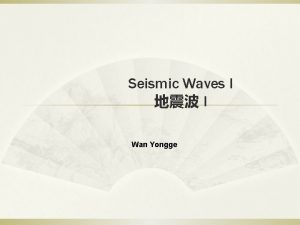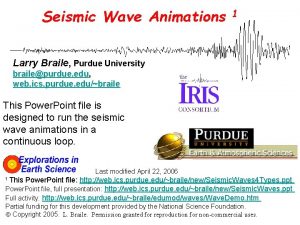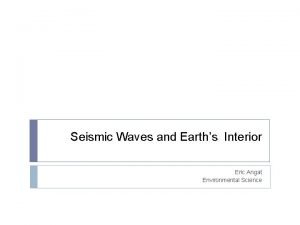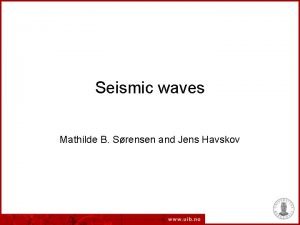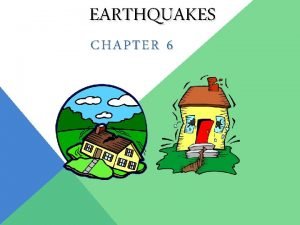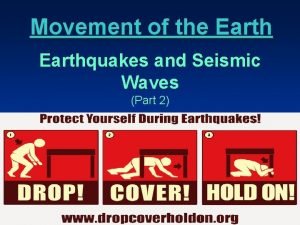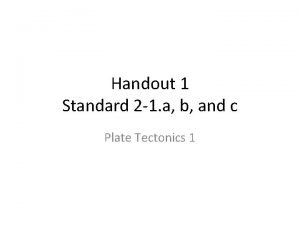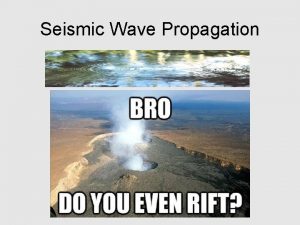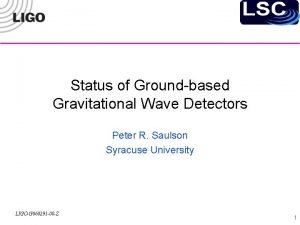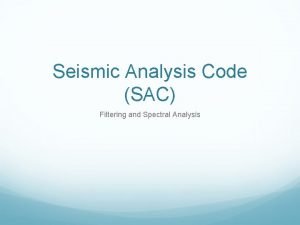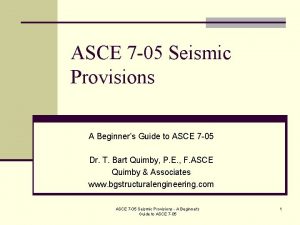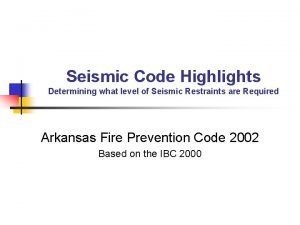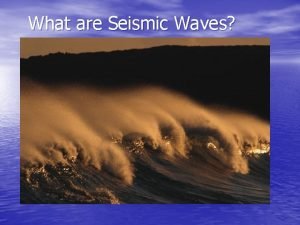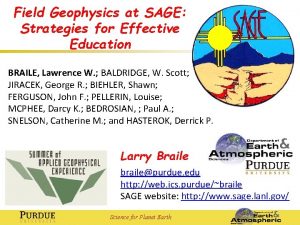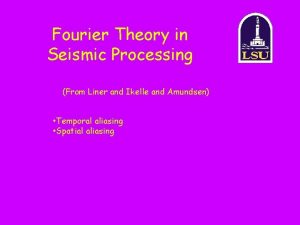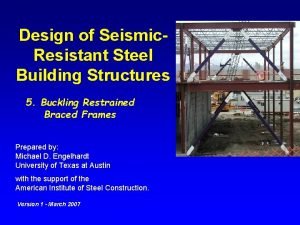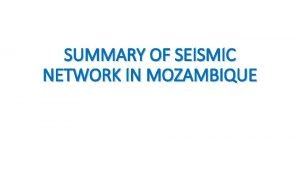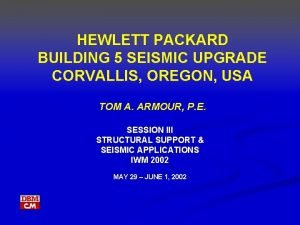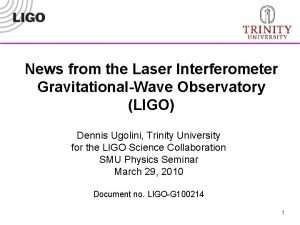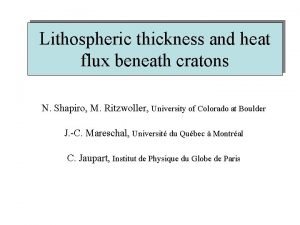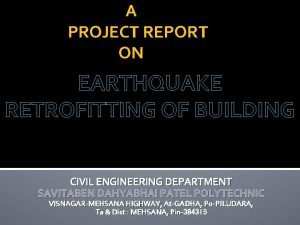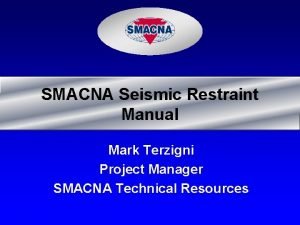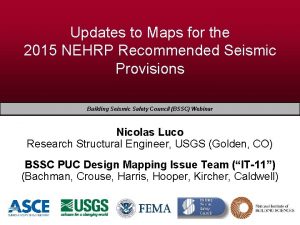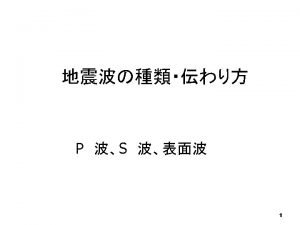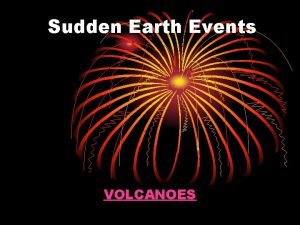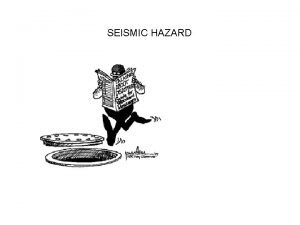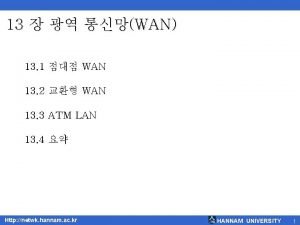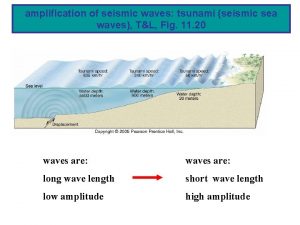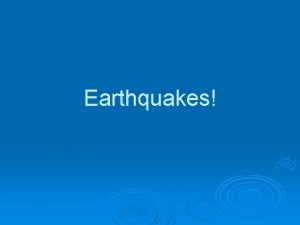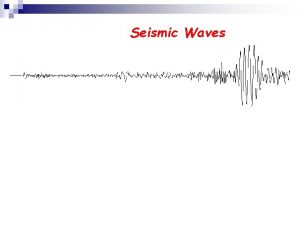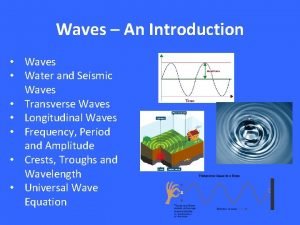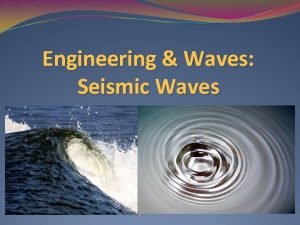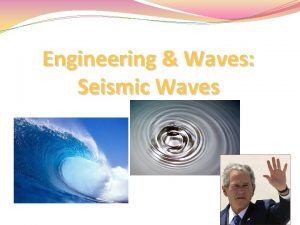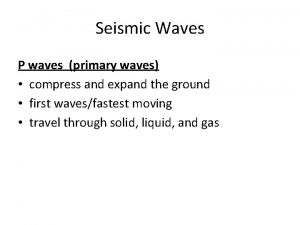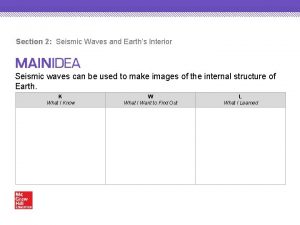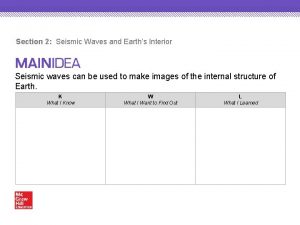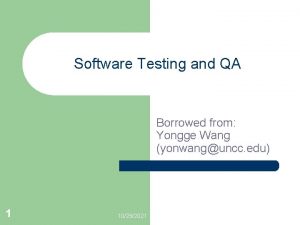Seismic Waves I I Wan Yongge Waves on
















































- Slides: 48

Seismic Waves I 地震波 I Wan Yongge

Waves on a string F=ma

Waves on a string Taylor’s series expansion


Waves on a string Fit Because

Waves on a string

Harmonic wave solution The displacement must be real.

Harmonic wave solution

Harmonic wave solution

Harmonic wave solution

Harmonic wave solution

Harmonic wave solution

Arbitrary function

Equation of motion Stress components contributing to force in the x 2 direction

Force in x 2 direction

Force in x 2 direction

Force in x 2 direction Total force in x 2 direction Total mass Acceleration F=ma yields

Equation of motion No body force, Homogeneous equation of motion

Equation of motion In Cartesian coordination, the x component Recall constitutive function for isotropic elastic medium: Then we have

Seismic wave equation Since

Seismic wave equation Combing into a single Vector equation

Seismic wave equation

Seismic wave equation The wave equation yields:

Seismic wave equation Reorganize As One solution of above equation can be found if both sides are 0

P wave Recall the wave equation Corresponding to wave with velocity

P wave Suppose wave along z direction Corresponding displacement u has nonzero component along z only, and dilatation of u Volume changes while wave propagates

Compressional Wave (P-Wave) Animation http: //web. ics. purdue. edu/~braile/edumod/ waves/Wave. Demo. htm#Wave_Animations Deformation propagates. Particle motion consists of alternating compression and dilation. Particle motion is parallel to the direction of propagation (longitudinal). Material returns to its original shape after wave passes.

S wave Corresponding to wave with velocity u has nonzero displacement along other two directions with no volume change

Shear Wave (S-Wave) Animation Deformation propagates. Particle motion consists of alternating transverse motion. Particle motion is perpendicular to the direction of propagation (transverse). Transverse particle motion shown here is vertical but can be in any direction. However, Earth’s layers tend to cause mostly vertical (SV; in the vertical plane) or horizontal (SH) shear motions. Material returns to its original shape after wave passes.

P and S Waves Wave Type (and names) Particle Motion Other Characteristics P, Compressional, Primary, Longitudinal Alternating compressions (“pushes”) and dilations (“pulls”) which are directed in the same direction as the wave is propagating (along the raypath); and therefore, perpendicular to the wavefront. P motion travels fastest in materials, so the P-wave is the first-arriving energy on a seismogram. Generally smaller and higher frequency than the S and Surface-waves. P waves in a liquid or gas are pressure waves, including sound waves. S, Shear, Secondary, Transverse Alternating transverse motions (perpendicular to the direction of propagation, and the raypath); commonly approximately polarized such that particle motion is in vertical or horizontal planes. S-waves do not travel through fluids, so do not exist in Earth’s outer core (inferred to be primarily liquid iron) or in air or water or molten rock (magma). S waves travel slower than P waves in a solid and, therefore, arrive after the P wave.

Rayleigh wave Considering a two dimensional situation, half space Free surface X or x 1, Elastic medium Z or x 2

Rayleigh wave The displacement must satisfy the wave equations and boundary conditions

Rayleigh wave After a long laborious process For poissonian,

Rayleigh wave amplitude Amplitude decay with depth, The sensitivity ~ 1/3 wave length

Rayleigh wave phase T/4 phase shift, reverse ellipse

Why surface waves have the largest amplitude?

Figure 2. 7 -3: Multiple surface waves circle the earth.


Rayleigh Wave (R-Wave) Animation On Waves Propagated along the Plane Surface of an Elastic Solid Proc. London Math. Soc. (1885) s 1 -17 (1): 4 -11 The existence of Rayleigh waves was predicted in 1885 by Lord Rayleigh, after whom they were named. John William Strutt, (12 November 1842 – 30 June 1919) was an English physicist who, with William Ramsay, discovered argon, an achievement for which he earned the Nobel Prize for Physics in 1904. He also discovered the phenomenon now called Rayleigh scattering, which can be used to explain why the sky is blue.

Love wave

Love wave Two boundary conditions yield: and By defining a new variable We get

Two ways to derive this period equation. See text book chap. 2. 7, pp 90 -91.


Love wave Augustus Edward Hough Love predicted the existence of Love waves mathematically in 1911. Augustus Edward Hough Love (17 April 1863, – 5 June 1940), often known as A. E. H. Love, was a mathematician famous for his work on the mathematical theory of elasticity.

Love Wave (L-Wave) Animation Deformation propagates. Particle motion consists of alternating transverse motions. Particle motion is horizontal and perpendicular to the direction of propagation (transverse). To aid in seeing that the particle motion is purely horizontal, focus on the Y axis (red line) as the wave propagates through it. Amplitude decreases with depth. Material returns to its original shape after wave passes.

Three-component seismograms for the M 6. 5 west coast of Chile earthquake recorded at NNA

Some mile stones in Seismology ß ß ß ß ß 1906,Oldham infer the earth structure with travel time; 1909,Moho Discontinuity proposed by Mohorovičić; 1914,Gutenberg found the shadow of seismic wave and deduced the depth of CMB; 1936,Lehmann further confirm the liquid outer core; 1940,Jeffreys-Bullen travel time table proposed; 1977,Aki & Dziewonski travel time tomography (Aki et al. , 1977) and whole mantle structure (Dziewonski et al. , 1977); 1981,Dziewonski & Anderson proposed PREM (Dziewonski & Anderson, 1981); 1987 and on,IASP 91 and AK 135 earth models proposed; 1996,Song and Richards confirmed the differential rotation of inner core(Song & Richards, 1996)。

Summary ß ß ß Wave on a string Wave equation Seismic wave P and S waves Rayleigh wave Love wave
 Yongge wang
Yongge wang Seismic waves are mechanical waves
Seismic waves are mechanical waves Private wan infrastructure
Private wan infrastructure P wave formula
P wave formula Four types of seismic waves
Four types of seismic waves P wave animation
P wave animation Which type of wave can penetrate the outer and inner core *
Which type of wave can penetrate the outer and inner core * Seismic
Seismic Whats the main cause of most earthquakes
Whats the main cause of most earthquakes Seismic wave types
Seismic wave types Seismic waves
Seismic waves Seismic wave front
Seismic wave front Seismic waves
Seismic waves Seismic waves types
Seismic waves types Seismic
Seismic Mechanical wave and electromagnetic wave
Mechanical wave and electromagnetic wave Short wave vs long wave radiation
Short wave vs long wave radiation Compare and contrast p waves and s waves using venn diagram
Compare and contrast p waves and s waves using venn diagram Difference between electromagnetic and mechanical waves
Difference between electromagnetic and mechanical waves Mechanical waves and electromagnetic waves similarities
Mechanical waves and electromagnetic waves similarities High and low frequency waves
High and low frequency waves Mechanical and electromagnetic waves
Mechanical and electromagnetic waves What type of waves are sound waves? *
What type of waves are sound waves? * Examples of mechanical and electromagnetic waves
Examples of mechanical and electromagnetic waves Light is an electromagnetic wave true or false
Light is an electromagnetic wave true or false Difference between constructive and destructive waves
Difference between constructive and destructive waves Is echolocation transverse or longitudinal
Is echolocation transverse or longitudinal Mechanical waves and electromagnetic waves similarities
Mechanical waves and electromagnetic waves similarities Seismic isolation
Seismic isolation Seismic analysis code
Seismic analysis code Asce 7-05 seismic
Asce 7-05 seismic Seismic design categories
Seismic design categories Type of earthquake waves
Type of earthquake waves Seismic reflection
Seismic reflection Seismic attributes
Seismic attributes Fourier transform seismic
Fourier transform seismic Design of seismic-resistant steel building structures
Design of seismic-resistant steel building structures Mozambique seismic
Mozambique seismic Deterministic seismic hazard analysis
Deterministic seismic hazard analysis Hewlett packard oregon
Hewlett packard oregon Seismic isolation
Seismic isolation Seismic inversion
Seismic inversion Project report on seismic retrofitting of buildings
Project report on seismic retrofitting of buildings 1 8 seismic cables manufacturer
1 8 seismic cables manufacturer Smacna seismic restraint manual
Smacna seismic restraint manual 2015 nehrp recommended seismic provisions
2015 nehrp recommended seismic provisions Seismic tomography
Seismic tomography Seismic wave cracker
Seismic wave cracker Seismic tomography ______.
Seismic tomography ______.



